The principle of operation and self-installation of septic tank "Topas"
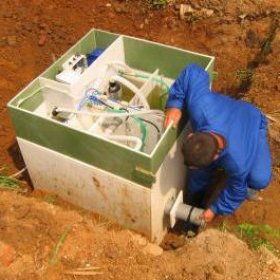
On the principle of "all inclusive" today, not only many hotels work, but also septic tanks, providing a complete cycle of wastewater treatment within one structure. This is convenient for owners who are deprived of the benefits of a common sewage system and are forced to call a sewage machine every month. And such services do not go to summer residents, so they have only two options: either a toilet on the street, as in the primitive century, or an expensive, but profitable septic tank. In the post-Soviet space, the treatment systems of the Russian manufacturer TOPOL-ECO, in particular, the Topas septic tank, are very popular.
The company claims that the system purifies domestic wastewater by more than 95%, and at the outlet the owners receive sludge for fertilizer and water for household needs (for example, for irrigation). But such a result can be achieved only with proper installation, operation and maintenance of the septic tank. Let's understand the nuances deeper.
The structure and principle of operation of "Tokas"
The peculiarity of the device “Septop” septic tank is that the whole structure is assembled in one housing, which is very convenient when installing the system. Purification of the contents occurs due to the vital activity of bacteria that feed on organic matter and lay it out on safe elements. Bacteria live inside the structure and maintain their numbers independently, fueled by sewage and oxygen.
If you open the lid and look inside the case, you will see that the septic tank is divided into 4 identical compartments, each of which performs its own functions. Two compressors are installed above the cameras in a separate plastic hopper, due to which the wastewater is advanced during the cleaning process and oxygen is pumped into the water.
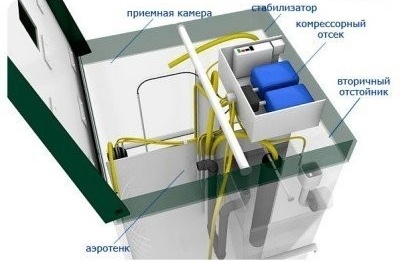
All four chambers of the septic tank Topopus are interconnected so that with a large influx of wastewater, the cleaning cycle accelerates, and with a weak one it improves due to the repeated distillation of sewage
In more detail on compartments:
- Compartment number 1. This is a camera that receives everything that enters the septic tank through sewer pipes. First, the effluent accumulates, but as soon as it rises to the level at which the float switch is installed, it sends a signal to the first compressor. Automation is triggered, and liquid effluents begin to flow into the second compartment. Large particles settle to the bottom of the chamber. At the junction 1 and 2 of the camera there is a coarse filter and a device for catching hair.
- Compartment number 2. Slightly filtered drains enter the compartment No. 2, called aeration tank. They are attacked by hungry bacteria, which break down large particles into simpler ones and clean water from organics. They are assisted by a compressor that supplies oxygen to the chamber. It provides the movement of effluents, mixing them with activated sludge. Sludge acts as a filter, binding solid particles and foreign bodies that have fallen into the septic tank with drains.
- Compartment number 3. All fluid agitated by the compressor and bacteria flows into the third compartment, which is called the secondary sump.Inside the compartment there is a pyramid where, with the help of an airlift, the contents with silt are fed. There, the effluents calm down, are separated into water and silt sediment. The old sludge, together with the associated components, settles to the bottom, and a fresh and lighter sludge is returned to compartment No. 1 to take part in further cleaning.
- Compartment number 4. Receiver for purified water. The clarified water flows through the top of the stilling pyramid into compartment No. 4. There she waits until she rises to the level of the outlet to leave the septic tank.
If there is no inflow of effluents to compartment No. 1 or they are not enough to trigger the float, then inside the septic tank there is a deeper purification of the contents. This is the so-called second phase of work. Drains circulate from chamber to chamber using an aeration tank compressor and airlifts.
The principle of operation of the Topas septic tank does not provide for long breaks in use. Anaerobic bacteria must receive "food" constantly, otherwise they will begin to die. Therefore, such a system is best used in homes where they live year-round or are at least for the weekend.
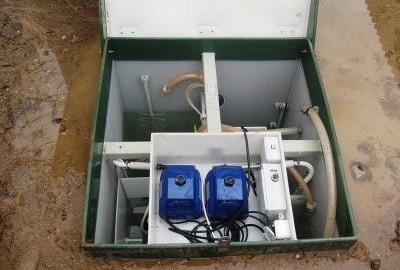
Compressors that pump oxygen and mix the drains in the aeration tank and in the receiving chamber are interchangeable, so if a breakdown occurs, it is easy to choose a replacement
Features of maintenance and operation of septic tank topop
In order for the system to function without failures (and the manufacturer indicates that the topas is capable of working for about 50 years!), It is necessary to properly operate and maintain it. Bacteria are “sensitive comrades,” so you won’t be able to drain everything that you could drain into a regular cesspool into the sewer.
Prohibited:
- Discard any insoluble components such as film, sand, lime, debris from mushrooms or berries, because they will enter chambers that cannot be cleaned and can clog compressors.
- Drain chlorine-containing and acid-containing products, alkalis, medicines, industrial oils, as well as decaying residues of fruit and vegetable products, because they cause the death of bacteria.
Exceed the allowable daily volume of effluents, because the quality of treatment will deteriorate.
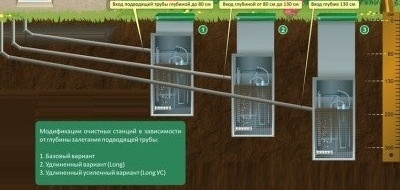
When choosing a specific Topas model, you need to pay attention to how many plumbing fixtures it can service. For example, Topop-5 is not designed for a bath and a washing machine.
Maintain the system as follows:
- Up to 4 times a year, sludge is removed with a drainage pump (can be used immediately as a fertilizer in the garden).
- Monthly clean the filter, retaining solid particles of large fractions.
- The membranes in the compressors are changed (once every two years).
They conduct a complete cleaning of the system and replace the aerators - once every 10-12 years.
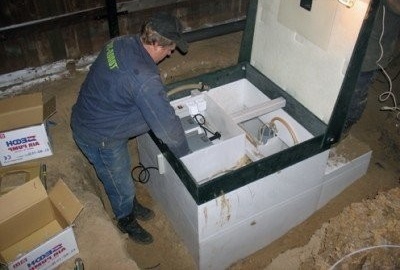
In winter, at temperatures below 15 degrees, the manufacturer does not recommend lifting the lid of the septic tank to check the condition, otherwise the system may leak
How to install the Topas septic tank yourself?
If you buy a model of septic tank "Topas" for the needs of one family, installation can be done by yourself. More powerful installations require the participation of large equipment and a lot of people, so it is better to seek help from specialized companies.
The main installation steps are as follows:
- A foundation pit is excavated, which should be 20 cm wider than the septic tank body on each side and 30 cm deeper.
- At the same time, they dig a trench into which a supply sewer pipe will be laid with a slope towards the septic tank. This is necessary for the normal movement of wastewater.
- If the pipe makes a turn in some places, then a viewing well is created on each bend.
- Strengthen the bottom of the pit. If the groundwater is low, then just pour a 30-cm layer of sand. At a high level of groundwater, a concrete base is poured (or a slab is laid), to which the structure is anchored with straps.
- A septic tank is placed on the base so that its lid and top of the body remain above ground level.This is necessary to avoid flooding the system during floods.
- Pipes are connected and a purified water outlet system is being established.
They insulate the case, cover and pipes from all sides. Expanded polystyrene, glass wool or other heat insulating material may be used. The free space between the insulation and the ground is covered with soil and compacted.

When digging a foundation pit manually, formwork is necessarily put in order to avoid soil collapse, and the bottom is lined with sand or poured with concrete
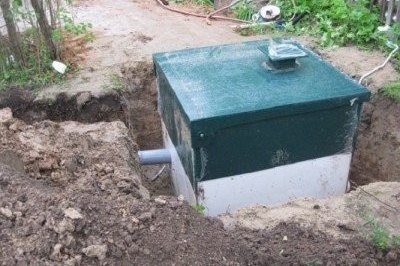
To prevent groundwater from entering the septic tank during the rainy and flood season, the lid and top of the hull are left above the soil level
In more detail, the installation process of the Topas septic tank can be studied in the following video:
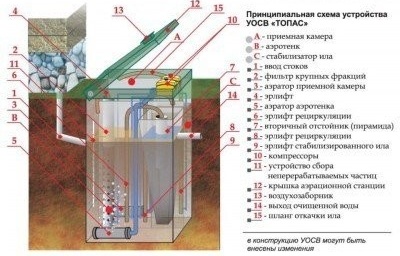
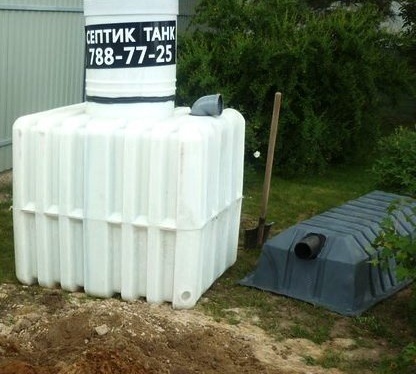
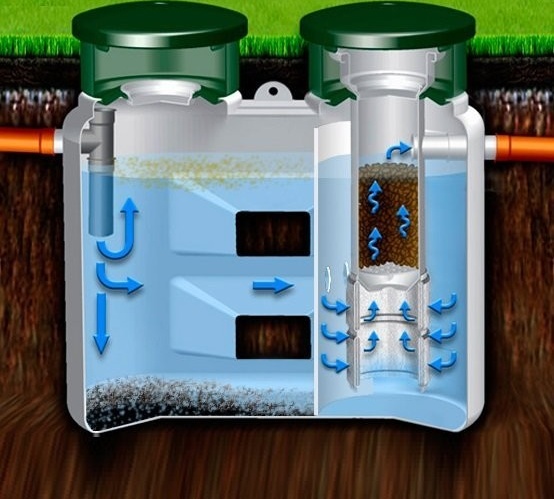
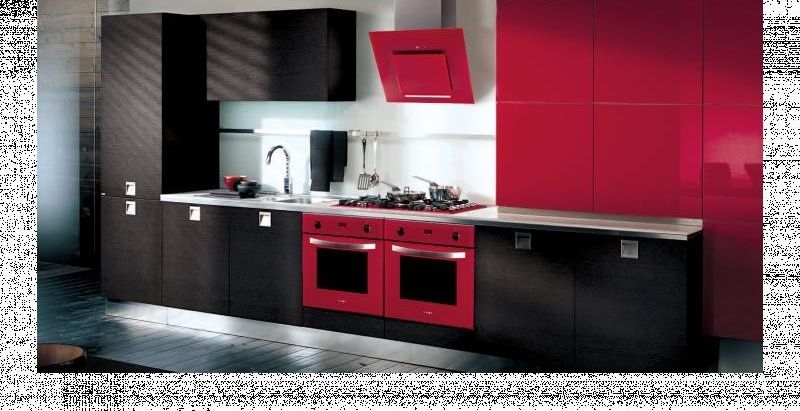
1 comment